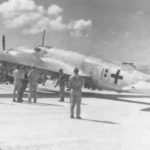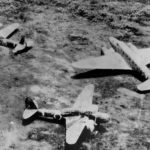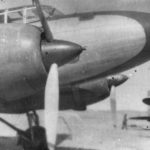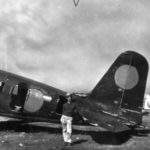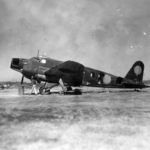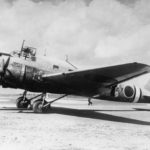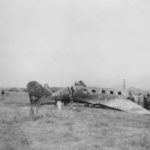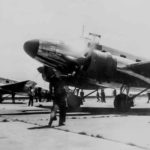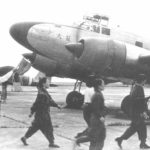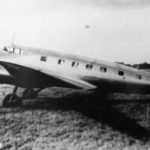White L2D4 and Ki-57 with surrender crosses Japan 1945
Ki-57 with Japanese surrender delegation 1945
Ki-57 1945
Transport aircraft Ki-57 Topsy
Captured Ki-57 “Topsy” 1945
Japanese aircraft wrecks at Hollandia Ki-48 and Ki-57 1944
Ki-57 nose
Captured MC-21 2
Captured “Topsy” Ki-57 Japan 1945
MC-20-II of the Dai Nippon Koku KK 1945 with green crosses
Ki-57 Japan 1945
MC-20-II
Ki-57 “Topsy” of Army flying school
Two Japanese Mitsubishi Ki-57 Topsy Transports
Passenger aircraft MC-20
Passenger aircraft MC-20 2
The Type 100 Transport Aircraft, Ki-57 was a transport aircraft of the Imperial Japanese Army during World War II. The Allied code name for the aircraft was Topsy. Developed and manufactured by Mitsubishi Heavy Industries. It was used as the main military transport aircraft of the Imperial Army in the Pacific War, and was also used as a civilian passenger aircraft under the name MC-20.
In 1939, the Army instructed Mitsubishi to develop a new transport aircraft, the Ki-57, the successor to the Type 97 transport aircraft Ki-34. The main idea was to redesign the fuselage part of the Type 97 heavy bomber Ki-21 for the transport of personnel. The performance of this aircraft inherited the characteristics of the mother Type 97 heavy bomber, and there was no particular problem in the flight test, so it was adopted as a type 100 transport aircraft. Other than the fuselage, the other differences between the Type 100 and the Type 97 were that the main wings were lowered from the middle wing, and the fuel tank in the outer wing (integral tank), which had been avoided in bombers because of its vulnerability to fire when hit, was installed so that it could be used as needed. This aircraft, which later became the Ki-57-I, was equipped with a Ha-5 Kai (850hp) engine, and in February 1942 it was used by paratroopers of the 1st Paratroopers Group during Operation Palembang, together with the Ki-56 cargo transport aircraft. In March of the same year, it was used for the inspection of the southern front by the Axis officers who came to Asia (Wehrmacht, Italian Army, Finnish Army, Romanian Army).
It was modified for paratroopers with wooden seats, large inward-opening doors, a window for the commander to look through, and gun ports on both sides of the passenger compartment. Part of the Type 1 (Ki-57-I) was transferred to the Navy for use as the L4M1. In particular, it inherited the characteristics of the 97 heavy bomber, which was a high-speed bomber when it was first introduced, the maximum speed of the aircraft outperformed the C-47, Ju 52, and L2D of the Navy (DC-3 (C-47) license production machine). It was superior to the twin-engine and three-engine transport aircraft of other countries. On the other hand, the disadvantage of this aircraft was that it had a smaller payload and a smaller number of passengers than other countries’ transport aircraft of the same size (the Ju 52 had 17 passengers, while the 100 transport had 11), probably because it was based on the slim fuselage of the 97 Heavy Bomb.
In 1942, the Ki-57-II was introduced with a Ha-102 engine (1,080hp), reinforced wings and an enlarged cargo bay, and served as the Army’s main transport aircraft until the end of the war, transporting personnel and supplies and towing gliders. The modifications made to the Type 2 (Ki-57-II), apart from engine conversion and wing strengthening, were as follows:
• Installation of a draining device in the central wing fuel tank (from Unit 23).
• Installation of emergency evacuation door using cabin window (from Unit 2)
• Relocation of the navigation room (from No. 23).
• Rotating tailwheel (from No. 100)
• Ice protection installed on wing leading edges and propellers.
• Collective exhaust pipes opened on the outside only (from No. 1)
• Seating capacity increased to 15 seats (from 405), which can be converted to couches for 17-19 passengers.
• Addition of a towing device for gliders (prototype in March 1944, standard equipment from August 1944)
The Mitsubishi MC-20 was a military transport aircraft that was also converted and manufactured as a civilian passenger aircraft under the name MC-20 (MC20), and was used by a number of airlines and newspaper companies, including Dai Nippon Airways and the Asahi Shimbun. The MC-20 was often referred to as the “MC Transport” even within the Army.
From 1941 to January 1945, a total of 507 aircraft (101 Type I and 406 Type II) were built by Mitsubishi for military and civilian use. This was the largest number of transport and passenger aircraft produced in Japan before the war.


